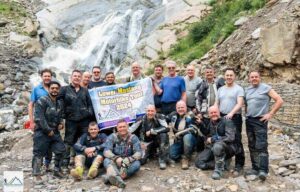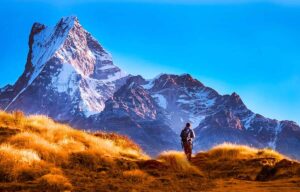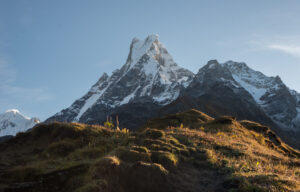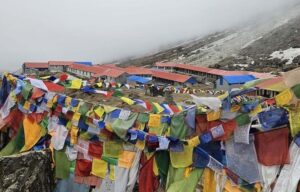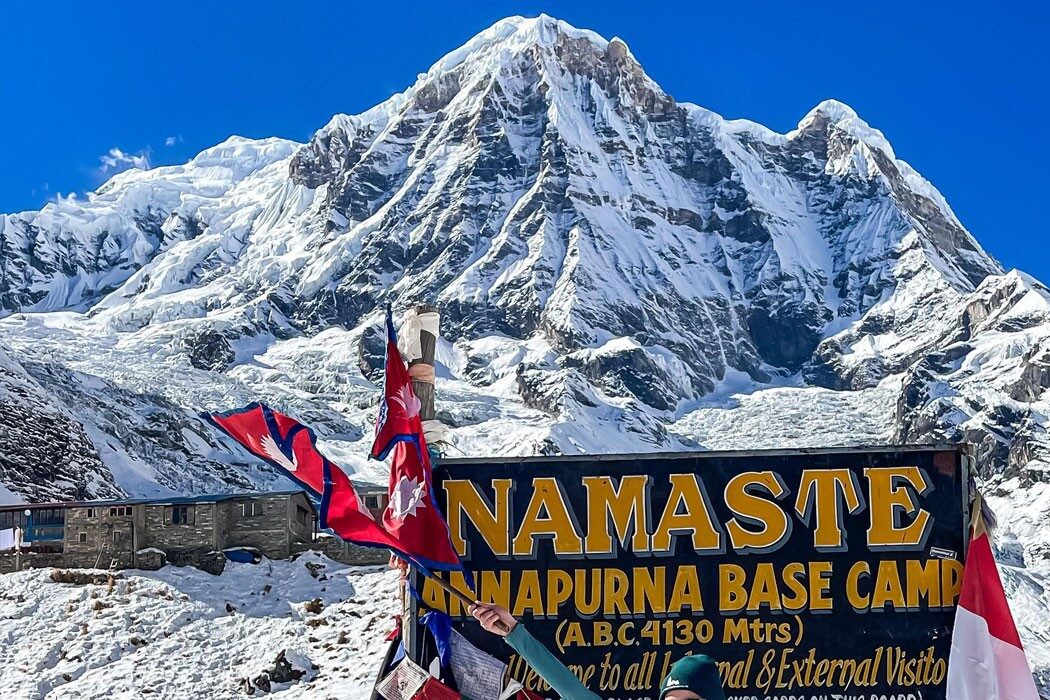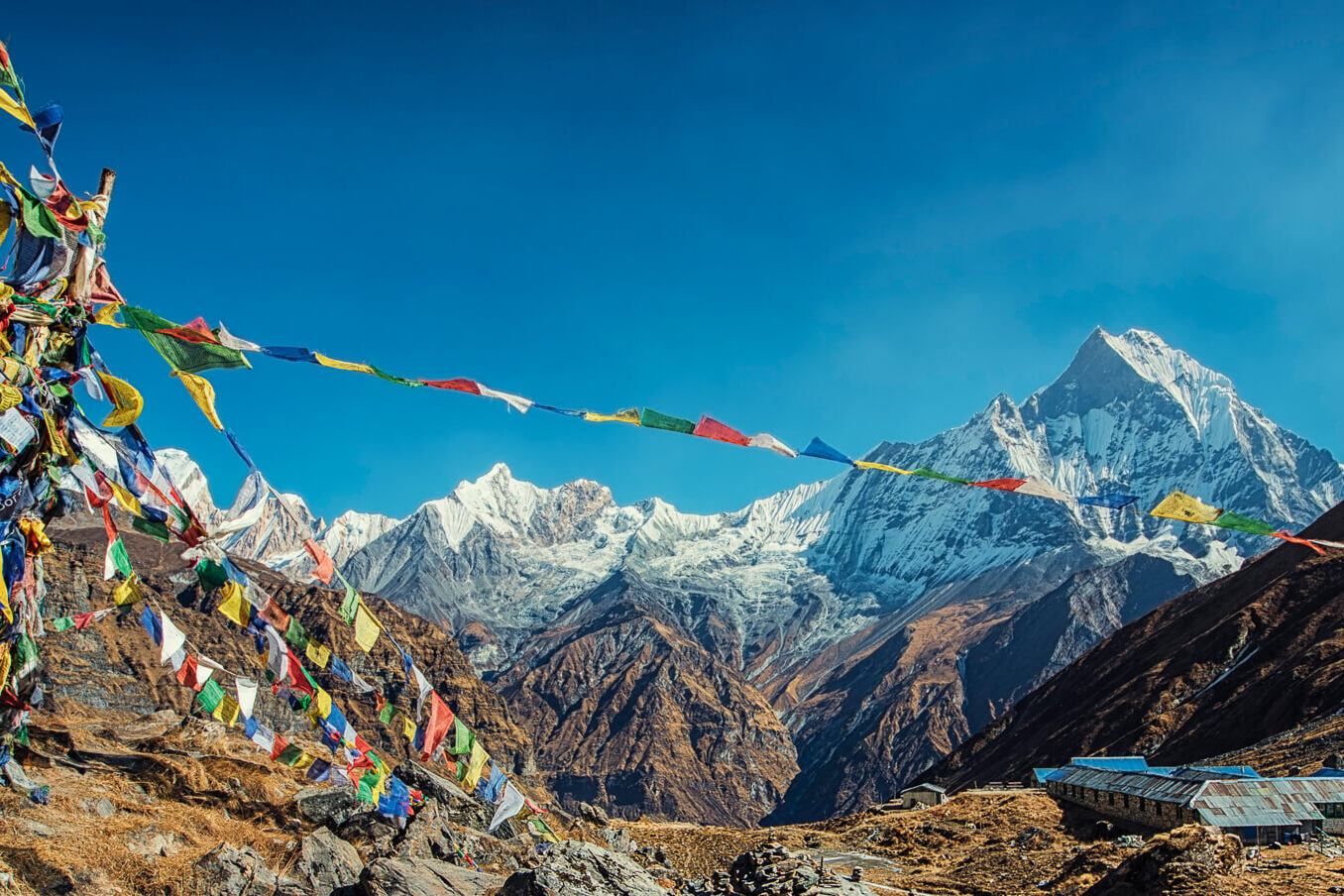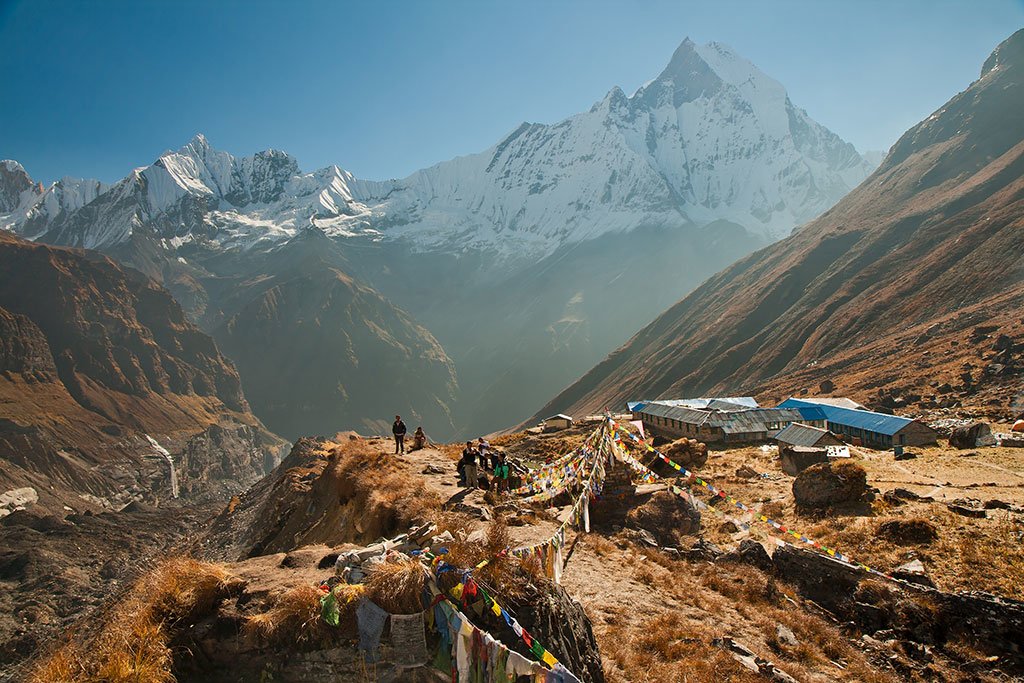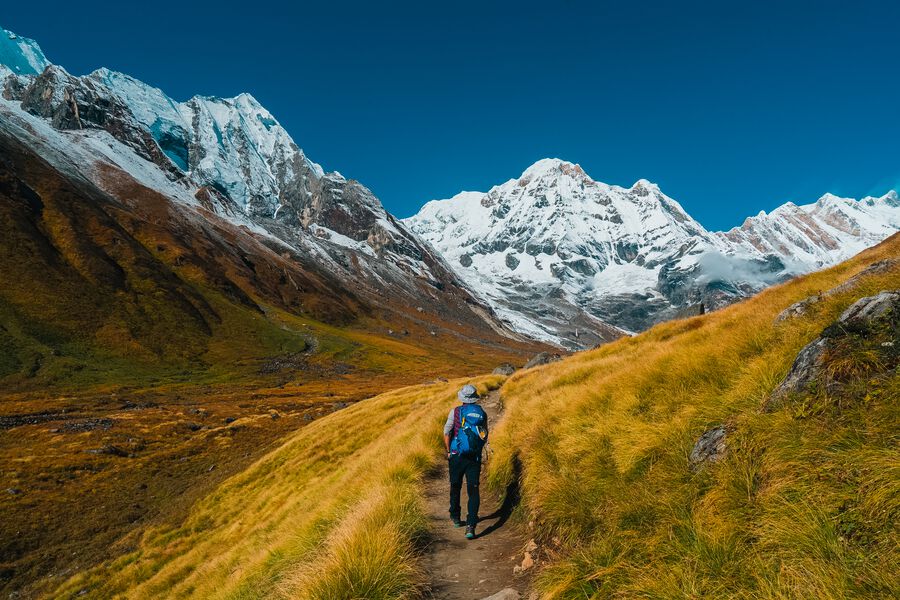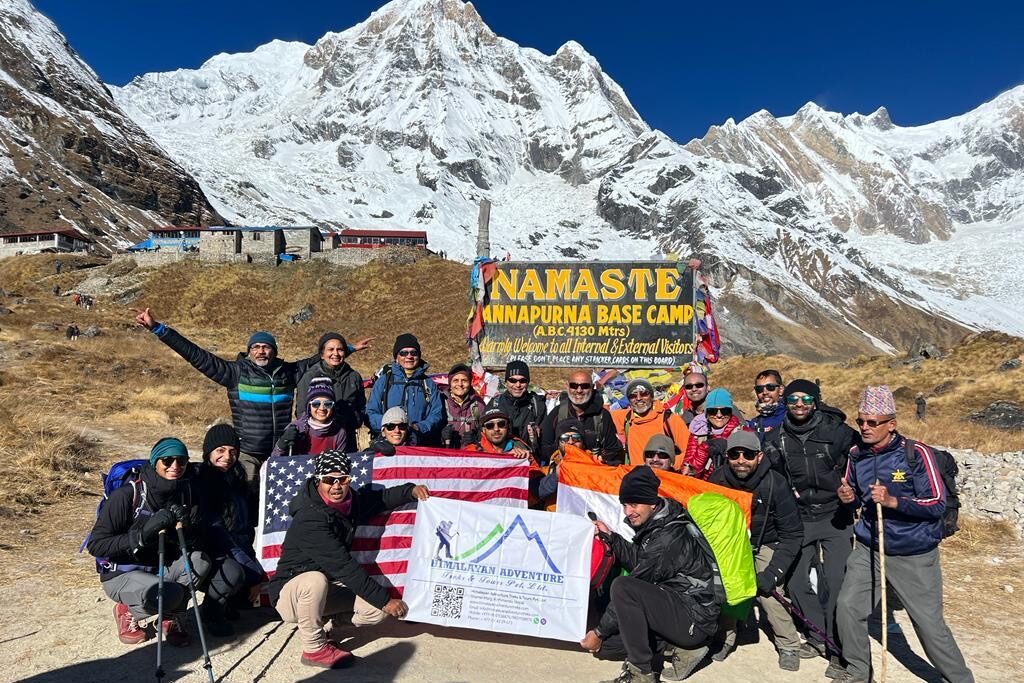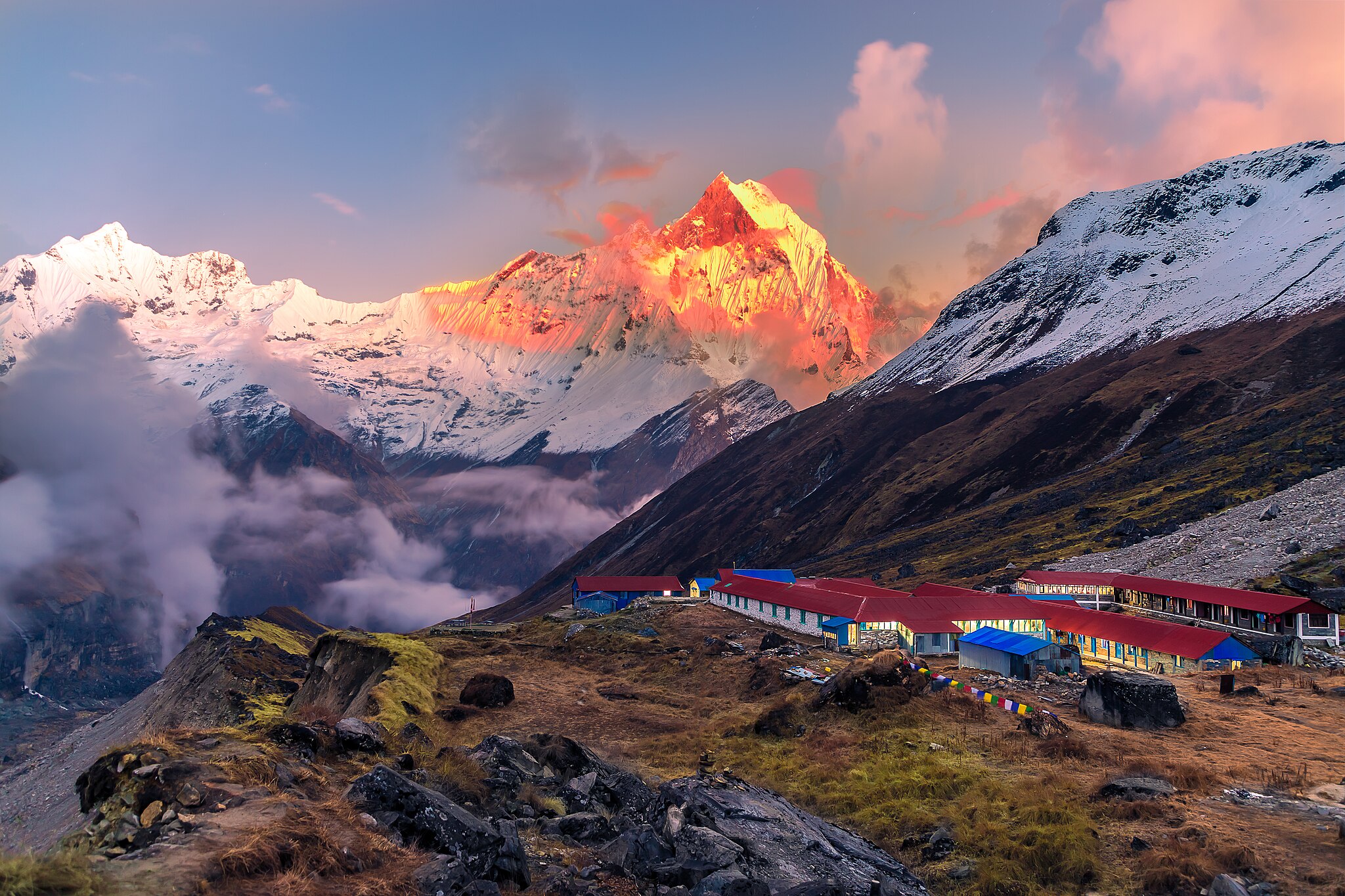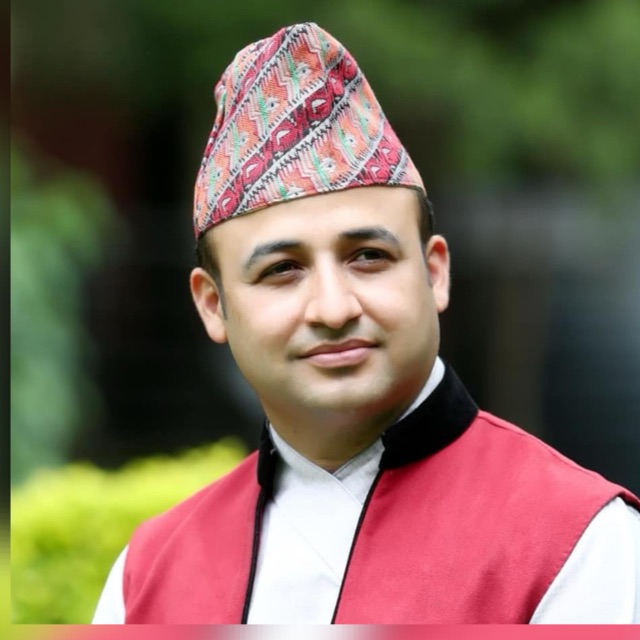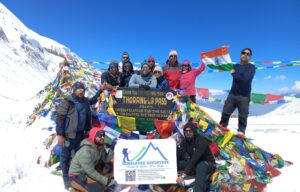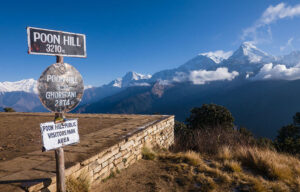Best Time to Travel
The Annapurna Base Camp Trek is best experienced during the following seasons:
- Spring (March to May): This is the most popular Annapurna Base Camp trekking season in Nepal. The weather is mild, with clear skies and blooming rhododendron forests adding vibrant colors to the trail. Temperatures range from 15°C to 20°C during the day, making it ideal for trekking.
- Autumn (September to November): Another peak season for trekking to Annapurna Base Camp is autumn. It offers clear skies and stunning views of the mountains. Here, the weather is stable, with daytime temperatures between 10°C and 15°C. This season is known for its festivals, like Dashain and Tihar, adding a cultural flavor to your journey.
- Winter (December to February): While the temperatures can drop significantly, especially at higher altitudes, the trek is still possible. The trails are less crowded, and the snow-covered landscapes offer a different kind of beauty. However, be prepared for colder conditions, with temperatures often dropping below freezing at night.
- Monsoon (June to August): During the monsoon season, it’s challenging to trek ABC due to heavy rainfall and slippery trails. However, the lush green landscapes and fewer crowds can appeal to some trekkers. Be prepared for leeches and the possibility of landslides.
A day in ABC Trek
On the Annapurna Base Camp trek, a normal day includes walking, eating, taking breaks to rest, and taking in the beautiful scenery. A typical day on the trail might look like the following:
In the morning:
6:00 AM to 7:00 AM: Get up early to see the sunrise and enjoy the peace and quiet of the morning. Get ready for the day by getting clean and packing your things.
From 7 a.m. to 8 a.m., you can have breakfast at the teahouse. Breakfast usually has a lot of different things, like eggs, toast, cereal, and tea or coffee.
Hiking:
From 8 a.m. to 12 p.m., start your day’s hiking. The pace changes based on the day’s journey and gain in elevation. Take in the different types of scenery, such as woods, rivers, terraced fields, and views of the mountains.
Lunch break at a teahouse along the trail from noon to one o’clock. Get some rest and food for the afternoon.
In the afternoon:
1:00 PM to 4:00 PM: Keep trekking, crossing different types of landscapes, and maybe meeting some animals in the area. Take short breaks to eat and drink.
4:00 PM to 5:00 PM: Get to your goal for the day, which is usually a teahouse in a village or a set place to rest. Soak up the mountain views and take it easy.
In the evening:
5:00 PM to 7:00 PM: Free time to rest, take pictures, or look around the area. On some days, you might take breaks to visit nearby sites or viewpoints.
From 7 PM to 8 PM, there will be dinner at the teahouse. Evening meals usually have a lot of different choices, like dal bhat (lentil soup with rice), noodles, veggies, and tea or coffee.
At night:
8:00 PM–9:00 PM: In the evening, you can hang out with other hikers, read, or just enjoy the peaceful mountain environment.
9:00 PM: Time to go to bed. Take a break and get ready for the next day of travel.
It’s important to stay hydrated, keep a steady pace, and pay attention to your body throughout the day. Getting enough rest, eating right, and acclimatizing are all very important for a good trek. Remember that the routine could change depending on the exact plan, the weather, and the preferences of each person. Also, days called “acclimatization” are often included in the plan to help hikers get used to being at higher elevations.
Accommodation and Dining
Accommodation:
- Kathmandu and Pokhara: You’ll stay in comfortable hotels with modern amenities, including hot showers, Wi-Fi, and dining options. Both cities offer a wide range of accommodations, from budget hotels to luxury resorts.
- During the Trek: Accommodation is in teahouses, which are basic lodges run by local families. Rooms are usually twin-sharing with shared bathrooms. While facilities are basic, they are clean and provide a warm and cozy place to rest after a day of trekking.
Dining:
- Kathmandu and Pokhara: A variety of dining options are available, from traditional Nepali cuisine to international dishes. Try local favorites like dal bhat (lentil soup with rice), momos (dumplings), and Newari cuisine.
- During the Trek: Meals are provided at the teahouses, with a menu that typically includes rice, noodles, soups, and bread. Dal bhat is a staple dish and is often the best option for energy during the trek. Hot beverages like tea, coffee, and hot chocolate are also available.
Food Hygiene and Safety
- Water: Drink only bottled or purified water. Water purification tablets or filters are recommended for use during the trek.
- Food Safety: Stick to well-cooked food. Avoid raw vegetables and salads unless you’re confident about their source. Teahouses generally maintain good hygiene standards, but it’s always wise to be cautious.
- Personal Hygiene: Hand sanitizer and wet wipes are essential for maintaining hygiene, especially in remote areas where washing facilities might be limited.
Cultural Insights
The Annapurna region is rich in cultural diversity, home to various ethnic groups, including the Gurung, Magar, and Thakali communities. The trek offers numerous opportunities to interact with local people and learn about their way of life.
- Gurung Culture: The Gurungs are known for their hospitality and are often involved in the trekking industry as guides and porters. Their villages, such as Chhomrong, are characterized by traditional houses and terraced fields.
- Festivals: If you trek during autumn, you may witness the Dashain and Tihar festivals, which are celebrated with much enthusiasm. These festivals are an excellent way to experience the local culture and traditions.
- Respect for Local Customs: Always greet locals with a “Namaste” and dress modestly, especially when visiting temples or religious sites. It’s also customary to walk clockwise around stupas and mani walls.
Environmental and Ethical Considerations
The Annapurna region is an environmentally sensitive area, and trekkers are encouraged to follow sustainable practices:
- Waste Management: Carry a reusable water bottle and avoid single-use plastics. Dispose of waste responsibly and use designated trash bins.
- Wildlife Conservation: Respect local wildlife and do not disturb their natural habitats. Avoid feeding animals and birds.
- Support Local Communities: Purchase goods and services from local businesses. Hiring local guides and porters not only enriches your experience but also supports the local economy.
Preparing for the Trek
- Physical Fitness: The Annapurna Base Camp Trek is a moderate to strenuous trek, requiring good physical fitness. Regular cardiovascular exercise, strength training, and hiking practice will help prepare your body for the demands of the trek.
- Mental Preparation: Trekking in the Himalayas can be physically challenging, but mental resilience is equally important. Be prepared for varying weather conditions, altitude changes, and long days of walking.
- Packing: Pack light but smart. Essentials include trekking boots, layered clothing, a warm jacket, a hat, gloves, and a good quality backpack. A detailed packing list is provided below.
Acclimatization and Health Precautions
- Altitude Sickness: As you ascend to higher altitudes, the risk of altitude sickness increases. Symptoms include headaches, dizziness, and nausea. The trek is designed to allow for gradual acclimatization, but it’s essential to listen to your body and inform your guide if you experience any symptoms.
- Hydration: Staying hydrated is key to preventing altitude sickness. Drink plenty of water throughout the day.
- Health Check: Consult your doctor before the trek, especially if you have pre-existing conditions. Carry a personal first aid kit with medications for common ailments like headaches, blisters, and stomach issues.
Preparing for the Annapurna Base Camp Trek requires a comprehensive approach that combines physical, mental, and technical training. Cardiovascular exercises like running, cycling, and swimming are essential to build the stamina needed for long days of trekking at high altitudes. Complementing this with strength training—focusing on legs, core, and upper body—ensures that your muscles are conditioned for the demanding ascents and descents. Regular hiking practice, especially on local trails or hills, helps simulate the trek’s conditions, allowing you to adapt to carrying a backpack over varying terrains.
Acclimatization is crucial for high-altitude trekking, and while you may not have access to high mountains for training, techniques like altitude simulation or training at higher elevations can prepare your body for the reduced oxygen levels you’ll encounter. Mental preparation is equally important, as the trek can be mentally challenging. Techniques like visualization, mindfulness, and setting small daily goals can help maintain focus and motivation.
Flexibility and balance exercises, such as yoga and stretching, are vital for preventing injuries and maintaining stability on uneven ground. Nutrition and hydration are also key; maintaining a balanced diet and staying well-hydrated during training will help optimize your performance and recovery. Finally, familiarizing yourself with your gear—like breaking in trekking boots, practicing with your backpack, and using trekking poles—ensures comfort and efficiency during the trek. By integrating these training methods, you can approach the Annapurna Base Camp Trek with confidence, well-prepared for the physical and mental challenges that lie ahead.
Difficulty Level:
The Annapurna Base Camp (ABC) Trek is considered a moderate to strenuous trek, requiring good physical fitness and endurance due to its varied challenges. The terrain is diverse, ranging from steep ascents and descents to rocky paths and stone steps, with some particularly demanding sections like the climb from Ulleri to Ghorepani and the final approach to the base camp. The trek reaches an altitude of 4,170 meters (13,550 feet), which, while not extremely high, can still pose risks of altitude sickness, making acclimatization crucial.
The Annapurna Base Camp trek typically spans 10-13 days, with daily trekking lasting 5-7 hours, which can be physically and mentally taxing, especially as the cumulative effects of the journey build. Weather conditions in the Annapurna region are unpredictable, with temperatures varying widely and potential for sudden rain or snow, adding to the difficulty. Trekkers need to be in good physical condition, particularly with strong cardiovascular fitness and leg strength, to manage the demands of the trek. Mental resilience is also vital, as the combination of physical exertion, altitude effects, and long days of trekking requires a positive mindset and determination.
While the ABC Trek is accessible to many, it is not recommended for those with significant health issues or a lack of fitness training. However, with proper preparation, including fitness training, acclimatization, and mental readiness, the trek is manageable and offers incredibly rewarding experiences, including stunning mountain views and rich cultural encounters, making the challenges well worth the effort.
Essential Equipment
Clothing
- Base Layers: Moisture-wicking base layers (thermal tops and bottoms) to keep you warm and dry.
- Mid Layers: Fleece jackets or sweaters for insulation.
- Outer Layer: A waterproof and windproof jacket and pants (Gore-Tex or similar) to protect against rain and wind.
- Trekking Pants: Comfortable, quick-drying pants; convertible pants (zip-off into shorts) can be useful.
- Down Jacket: A lightweight down jacket for warmth during cold nights and early mornings.
- Trekking Shirts: Lightweight, moisture-wicking shirts (both short and long-sleeved).
- Thermal Underwear: Essential for keeping warm at higher altitudes.
- Underwear and Socks: Moisture-wicking underwear and trekking socks; bring several pairs.
- Hat and Gloves: A warm hat (wool or fleece) and gloves (liner gloves and insulated gloves) to protect against the cold.
- Sun Hat and Sunglasses: A wide-brimmed hat for sun protection and UV-protected sunglasses.
Footwear
- Trekking Boots: Sturdy, waterproof boots with good ankle support. Ensure they are well broken in before the trek.
- Camp Shoes: Lightweight shoes or sandals for relaxing in the evenings at the teahouses.
- Gaiters: Optional, but useful for keeping debris and moisture out of your boots, especially in muddy or snowy conditions.
Backpacks
- Daypack (20-30 liters): A comfortable daypack to carry essentials like water, snacks, camera, and layers during the trek.
- Trekking Backpack (40-60 liters): If you’re not hiring a porter, you’ll need a larger backpack to carry all your gear.
Sleeping Gear
- Sleeping Bag: A sleeping bag rated for at least -10°C (14°F), as nights can get very cold at higher altitudes. Consider renting one in Kathmandu or Pokhara if you don’t have one.
- Sleeping Bag Liner: Adds extra warmth and keeps your sleeping bag clean.
Trekking Gear
- Trekking Poles: Adjustable poles to help with balance and reduce strain on your knees, especially during steep ascents and descents.
- Headlamp: A reliable headlamp with extra batteries, essential for early morning starts or when staying in teahouses without electricity.
- Water Bottles or Hydration System: Refillable water bottles or a hydration bladder with at least 2-3 liters capacity. Consider bringing a backup bottle.
- Water Purification: Tablets, drops, or a filtration system to purify water from local sources.
Other Essentials
- Personal First Aid Kit: Include basics like band-aids, blister treatment, painkillers, antiseptic wipes, and any personal medications.
- Toiletries: Biodegradable soap, toothbrush, toothpaste, quick-dry towel, wet wipes, hand sanitizer, and toilet paper (often not provided in teahouses).
- Sun Protection: High SPF sunscreen, lip balm with SPF, and sunblock.
- Snacks: Energy bars, trail mix, or other high-calorie snacks for quick energy boosts during the trek.
- Camera: To capture the stunning scenery, along with extra batteries and memory cards.
- Portable Charger/Power Bank: Essential for keeping your devices charged, especially as electricity can be limited.
- Trekking Map/Guidebook: Handy for navigating the trail and learning more about the region.
Optional Items
- Altitude Sickness Medication: Consult your doctor for advice on taking Diamox or other altitude sickness prevention medication.
- Book or Journal: For downtime at the teahouses.
- Travel Pillow: For added comfort while sleeping.
- Dry Bags: To keep your gear dry in case of rain.
- Multi-tool or Knife: Useful for a variety of situations.
- Duct Tape or Repair Kit: For quick fixes on the trail.
Airport Transfer
We provide airport transfer services to ensure a seamless start and end to your adventure. Upon arrival at Tribhuvan International Airport in Kathmandu, our representative will be there to greet you and assist with your luggage. You’ll be transferred to your hotel in a comfortable, private vehicle. At the end of your trek, we’ll arrange for your transfer back to the airport, ensuring you reach your flight on time and without hassle.
Trekking and Climbing Guide
Our team of experienced, English-speaking trekking and climbing guides are local experts with extensive knowledge of the Annapurna region. They are trained in high-altitude trekking, first aid, and emergency response, ensuring your safety and well-being throughout the trek. Our guides are also well-versed in the local culture, history, and geography, making your trek both informative and enjoyable.
Porter Service for Mera Peak Climbing
For those who are also considering the Mera Peak Climb, we offer porter services to assist with carrying your gear. Our porters are highly experienced and accustomed to the demands of high-altitude trekking. Each porter carries a maximum load of 15-20 kg, allowing you to trek more comfortably and focus on enjoying the journey. We ensure that our porters are treated fairly, provided with proper equipment, and compensated according to industry standards.
Travel Insurance
Travel insurance is mandatory for all participants in the Annapurna Base Camp Trek. Your insurance should cover high-altitude trekking (up to 5,000 meters) and include coverage for emergency evacuation, medical expenses, trip cancellation, and loss or theft of personal belongings. We recommend purchasing insurance from a reputable provider well before your departure and bringing a copy of your policy details with you.
Culture
The Annapurna region is rich in cultural diversity, home to various ethnic groups, including the Gurung, Magar, and Thakali communities. The trek offers an immersive cultural experience as you pass through traditional villages, interact with local people, and witness their daily lives. You’ll have the opportunity to visit local monasteries, participate in traditional ceremonies, and taste authentic Nepali cuisine. Respecting local customs and traditions is crucial; always greet locals with a “Namaste,” dress modestly, and ask for permission before taking photographs, especially in sacred or private spaces.
Flights and Transportation
- International Flights: Several international airlines fly to Kathmandu from major cities worldwide. It’s advisable to book flights well in advance, especially during peak trekking seasons.
- Domestic Flights: A domestic flight from Kathmandu to Pokhara is an option if you prefer not to drive. The flight offers stunning views of the Himalayas and takes about 25 minutes.
- Ground Transportation: Private vehicles are used for all transfers, including the drive from Kathmandu to Pokhara and the return journey.
Emergency Preparedness
Communication During Emergencies
- Mobile Coverage: Mobile network coverage is available in most areas of the trek, but it may be unreliable at higher altitudes. Consider purchasing a local SIM card with data or using a satellite phone for better connectivity.
- Emergency Contacts: Keep a list of emergency contacts, including your tour operator, local guide, and embassy.
Responsible Tourism
Responsible tourism ensures that the beauty and culture of the Annapurna region are preserved for future generations:
- Respect Local Cultures: Engage with locals respectfully, observe their customs, and learn about their way of life. Support local businesses by purchasing locally made products and services.
- Environmental Impact: Minimize your environmental footprint by following Leave No Trace principles. Avoid littering, reduce plastic usage, and conserve water and energy.
Additional Information
- Weather: The weather in the Himalayas can change rapidly, so be prepared for all conditions. Even in the warmer months, temperatures can drop significantly at higher altitudes.
- Trekking Permits: Ensure you carry your ACAP and TIMS permits with you at all times during the trek. These are required at various checkpoints.
- Currency: The local currency is the Nepalese Rupee (NPR). It’s advisable to carry cash, especially in remote areas where ATMs are not available.
Things to Know
- Altitude Awareness: Be mindful of the signs of altitude sickness, and do not push yourself too hard. Acclimatization is key to a successful trek.
- Teahouse Etiquette: Teahouses are often family-run, so be respectful of their customs. It’s common to remove your shoes before entering the living area.
- Hydration: Always drink purified or boiled water. Dehydration can exacerbate altitude sickness and affect your overall health during the trek.
